
 |
|
|
|
MORTAR
AND PESTLE GRINDING PROCEDURE
(TRACE METAL QUALITY) AND ALIQUOT MAKING |
|
Materials Required:
|
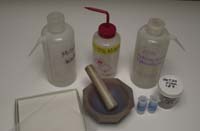 |
|
Rinse the agate mortar and
pestle with warm, soapy, tap water and scrub it out with a NYLON brush.
Rinse with tap water. Wipe the surfaces of the mortar and pestle with a Kimwipe. |
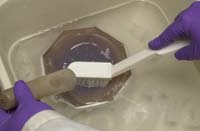 |
|
Squirt approximately .25
mL of 20% hydroxylamine hydrochloride solution into the mortar. Using the pestle, work the 20% hydroxylamine hydrochloride solution over all of the surfaces of the bowl. This reducing agent will dissolve manganese and iron oxides. Pour off the hyroxylamine hydrochloride into a waste container. |
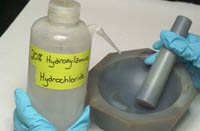 |
|
Squirt approximately .25 mL
of 5% nitric acid into the mortar. Using the pestle, work the 5% nitric acid over all of the surfaces of the bowl. Pour off the 5% nitric acid into a waste container. |
 |
|
Rinse at least three times with copious amounts of Milli-Q water. Place the mortar and pestle in a filtered air laminar flow hood to dry. |
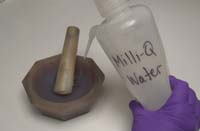 |
|
Empty the contents (approx.
16g) from the specimen container into the clean and dry mortar. |
 |
|
Disaggregate the entire sample
to the point that aggregates are broken but individual grains are not
ground. The disaggregated sample will
be used for Gamma Analysis. |
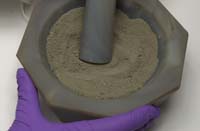 |
| Pour sediment onto a piece of weighing paper and transfer into a counting jar. | 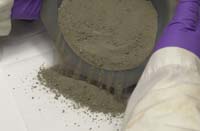 |
| Immediately spoon
3-5 grams of sediment onto a tared piece of weighing paper on a balance. |
 |
| Pour the weighed sediment back into the mortar. Continue grinding until the sediment is no longer gritty (like face powder). |
 |
| Transfer about
1 gram of the finely ground sediment into an acid washed and tared 10 dram
plastic vial with a snap top. Write the net weight on the side of the vial. *This ground portion of the sample can be used for trace metals or CHN analysis although CHN samples are usually ground with a Ball Mill Grinder. |
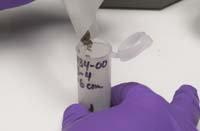 |
| |
 Return
to Index
Return
to Index |